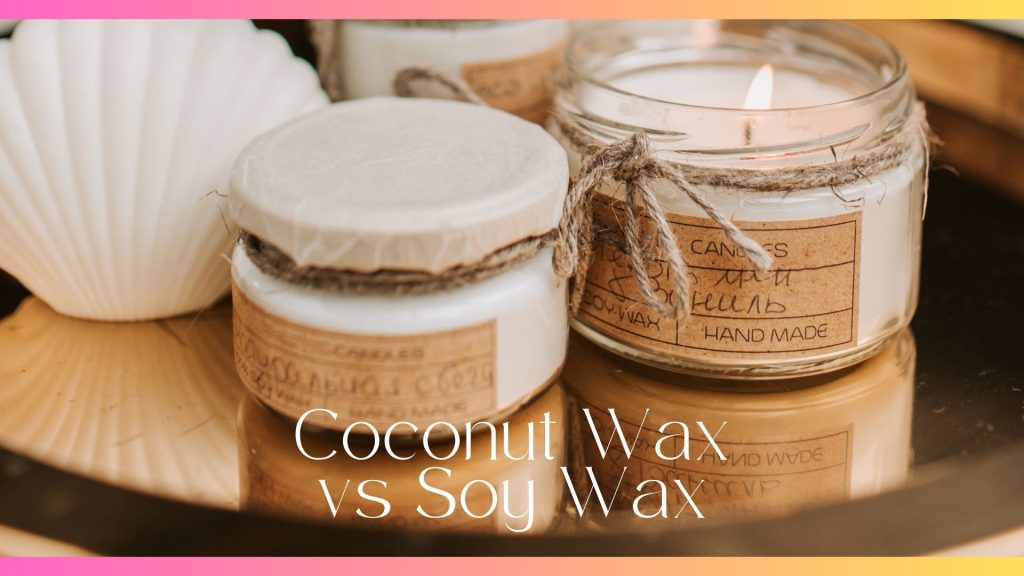Comparing coconut wax vs beeswax for candle-making? Here’s everything you should know before deciding which one is the right one for you.
In this article, I’ll discuss the differences between coconut wax and beeswax, including what makes them a good wax option for candle-making.
Disclaimer: This post may contain affiliate links. This means I may earn a small commission (at no cost to you) if you sign up for a program or make a purchase using my link!
Related Posts:
- Soy Candles vs Coconut Candles for Candle-making
- How To Make Coconut Wax Candles with Essential Oils
- How Long Do Coconut Wax Candles Need To Cure?
What is Candle Wax?
Candle wax is a solid material that melts and solidifies, allowing it to fuel the flame and maintain the shape of the candle. The type of wax you use influences the burn quality and aesthetic appeal of your candles.
Candle wax is the fundamental material used in creating candles. It determines how long your candle will burn, how it smells, and how it looks. Knowing the different types of wax available can guide you in making an informed decision.
Common Types of Candle Wax
It’s common to find candles made of paraffin wax, soy wax, beeswax, coconut wax and palm wax. Each of these waxes have unique characteristics that affect burn time, scent throw, and environmental impact.
The Pros and Cons of Coconut Wax
Coconut wax is produced from the hydrogenation of coconut oil. It’s a natural, renewable resource known for its eco-friendly properties and excellent performance in candles.
Benefits of Coconut Wax
- Eco-Friendly: Coconut wax is sustainable and biodegradable.
- Excellent Scent Throw: It disperses fragrance effectively.
- Long Burn Time: Coconut wax candles tend to burn longer.
- Smooth Texture: It has a creamy and luxurious appearance.
Drawbacks of Coconut Wax
- Cost: Generally more expensive than other waxes.
- Availability: Can be harder to find compared to more common waxes.
- Lower Melting Point: Can be an issue in warmer climates.
The Pros and Cons of Beeswax
Beeswax is a natural wax produced by honeybees. It’s harvested from the hive and has been used for various purposes, including candle-making, due to its purity and excellent burning properties.
Benefits of Beeswax
- Natural and Pure: Beeswax is a natural byproduct of beekeeping.
- Clean Burning: Produces very little soot.
- Pleasant Aroma: Emits a natural honey scent.
- Long Burn Time: Beeswax candles burn longer than many other types.
Drawbacks of Beeswax
- Cost: Beeswax is one of the more expensive waxes.
- Hardness: Can be more challenging to work with.
- Color Limitations: Naturally has a yellowish tint, limiting color options.
15 Differences Between Coconut Wax and Beeswax
| Aspect | Coconut Wax | Beeswax |
|---|---|---|
| Source | Derived from refined coconut oil | Produced by honeybees |
| Sustainability | Eco-friendly, biodegradable, renewable | Natural, biodegradable, renewable, but dependent on bee populations |
| Burn Quality | Burns cleanly with minimal soot | Burns cleanly with no soot |
| Scent Throw | Excellent scent throw, holds fragrance well | Mild, natural honey scent, can hold additional fragrance oils |
| Texture | Smooth and creamy | Hard and firm, natural golden color |
| Melting Point | Lower melting point, around 100-110°F (38-43°C) | Higher melting point, around 144-149°F (62-65°C) |
| Burn Time | Long burn time, consistent burn | Longest burn time among natural waxes |
| Color | Naturally white, can be colored easily | Natural yellow to golden brown, can be bleached or colored |
| Fragrance Compatibility | Compatible with a wide range of fragrance oils and essential oils | Limited due to strong natural scent, but can blend with mild oils |
| Environmental Impact | Low impact, supports sustainable agriculture | Low impact, supports beekeeping and biodiversity |
| Use in Candle Making | Ideal for container candles, smooth finish | Ideal for pillar, taper, and molded candles, often used in blends |
| Availability | Growing in popularity, becoming more widely available | Widely available but can be expensive |
| Cost | Generally higher due to production processes | Higher cost, premium pricing |
| Health Concerns | Non-toxic, safe for indoor air quality | Non-toxic, emits negative ions that can improve air quality |
| Hardness | Softer, may need blending for certain candle types | Very hard, suitable for various candle types |
The table above should provide you with an overview of the differences between coconut wax and beeswax when it comes to candle-making.
Summary of Differences: Coconut Wax vs Beeswax
In summary, both waxes are considered to be sustainable as they are both renewable resources. However, there can be questions on whether the beekeeping practices is ethical and sustainable especially when produced in large quantities.
Both coconut wax and beeswax are biodegradable, breaking down naturally over time and reducing their environmental footprint. When made into candles, these two waxes are non-toxic, burns cleanly and produces little soot. Some may even prefer beeswax candles due to its air-purifying qualities when used indoors.
If you’re concerned about general candle performance, both coconut wax and beeswax candles have long burn times, but beeswax should last longer than coconut wax candles. If you’re particular about scent throw, coconut wax has a better scent throw and holds fragrances better than beeswax.
Beeswax candles naturally emits a pleasant honey scent, which can enhance the fragrance of added essential oils. For appearance, coconut wax has a smooth, creamy appearance, adding a luxurious touch to candles. Beeswax has a natural yellowish tint and a rustic, natural look.
When comparing prices, both coconut wax and beeswax can be expensive to source, especially when compared to soy wax or paraffin wax. While both waxes are pricier, their long burn time and eco-friendly properties offer good value for money.
Coconut Wax vs Beeswax for Candle Making Cost
As a candle-maker, one of the biggest concerns in production would be cost. Although you would want your candles to be of high quality, sustainable and unique, you’ll need to consider the prices of every ingredient used.
Generally, beeswax tends to be more expensive than coconut wax. Both are a little difficult to source compared to soy wax but the production of beeswax involves labor-intensive beekeeping processes – which is more tedious than coconut wax.
There’s also growing demand for beeswax lately but there might not be enough supply to match.
Coconut wax, on the other hand, is derived from the meat of coconuts, which are abundant and easier to source. While still considered a premium wax, coconut wax is generally more affordable than beeswax. For larger scale production or budget-conscious projects, coconut wax might be the more economical choice.
Bottom Line
It’s always wise to really compare the true properties of the wax you’re using for your candles. As seen above, both coconut wax and beeswax have their own advantages and disadvantages.
If I were to provide a recommendation for you, it would be to choose coconut wax as they’re much easier to work with compared to beeswax. But if you’re a complete beginner, soy wax is an even easier wax to explore – especially when it comes to making scented candles.
With all decisions, consider your specific needs and preferences when choosing the wax that best fits your candle-making projects!
Frequently Asked Questions (FAQs)
Coconut wax candles, while highly valued for their clean burn and excellent scent throw, do have some disadvantages. One primary drawback is their higher cost compared to other types of wax like soy or paraffin. This can make coconut wax less accessible for budget-conscious candle makers or consumers. Additionally, pure coconut wax is quite soft and can have a low melting point, making it challenging to use on its own without blending with harder waxes for better structural integrity. Coconut wax is also less widely available than more common waxes, which can limit sourcing options. Finally, although it is eco-friendly, its softness may lead to issues like melting in warmer climates or during shipping.
The best wax for candle making depends on individual preferences and goals. Soy wax is highly recommended for beginners due to its ease of use, affordability, and clean burn. It offers a good balance of performance and environmental benefits. Coconut wax is excellent for those prioritizing a luxurious finish and superior scent throw, although it can be more expensive and softer. Beeswax is ideal for natural, health-conscious candle makers because of its air-purifying properties and pleasant natural scent, despite its higher cost. Paraffin wax remains popular for vibrant colors and strong scent throw, but it is not eco-friendly.
Coconut wax is excellent for candle making. It is derived from the meat of coconuts, making it a natural and renewable resource. It offers a clean burn with minimal soot, which helps maintain better indoor air quality and cleaner candle jars. Its creamy, smooth texture holds color well and creates a luxurious appearance. Additionally, coconut wax has an outstanding scent throw, both hot and cold, making it ideal for scented candles. While it is more expensive and softer than some other waxes, requiring blending with harder waxes for certain applications, its performance and eco-friendly nature make it a popular choice among high-end candle makers.
Beeswax is often considered the healthiest wax to use for candles. It is a natural, renewable resource that burns cleanly and produces minimal soot. Beeswax candles can help purify the air by releasing negative ions, which can bind to and remove pollutants and allergens from the air. Additionally, beeswax has a natural honey scent and does not require added fragrances or chemicals, reducing potential exposure to synthetic substances. Coconut wax is another healthy option, offering a clean burn and being free from harmful toxins and pollutants. Both beeswax and coconut wax are excellent choices for those looking for healthier waxes.


